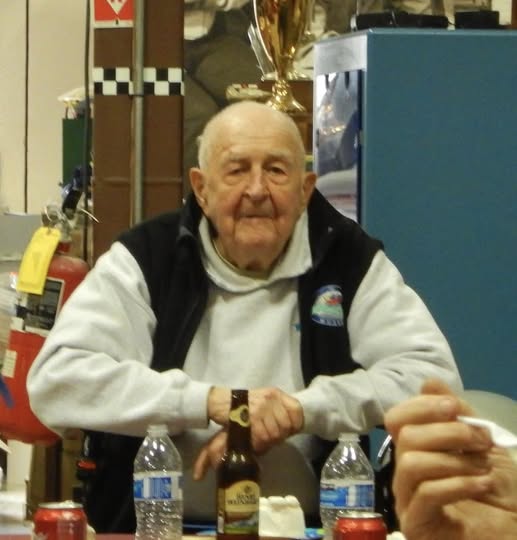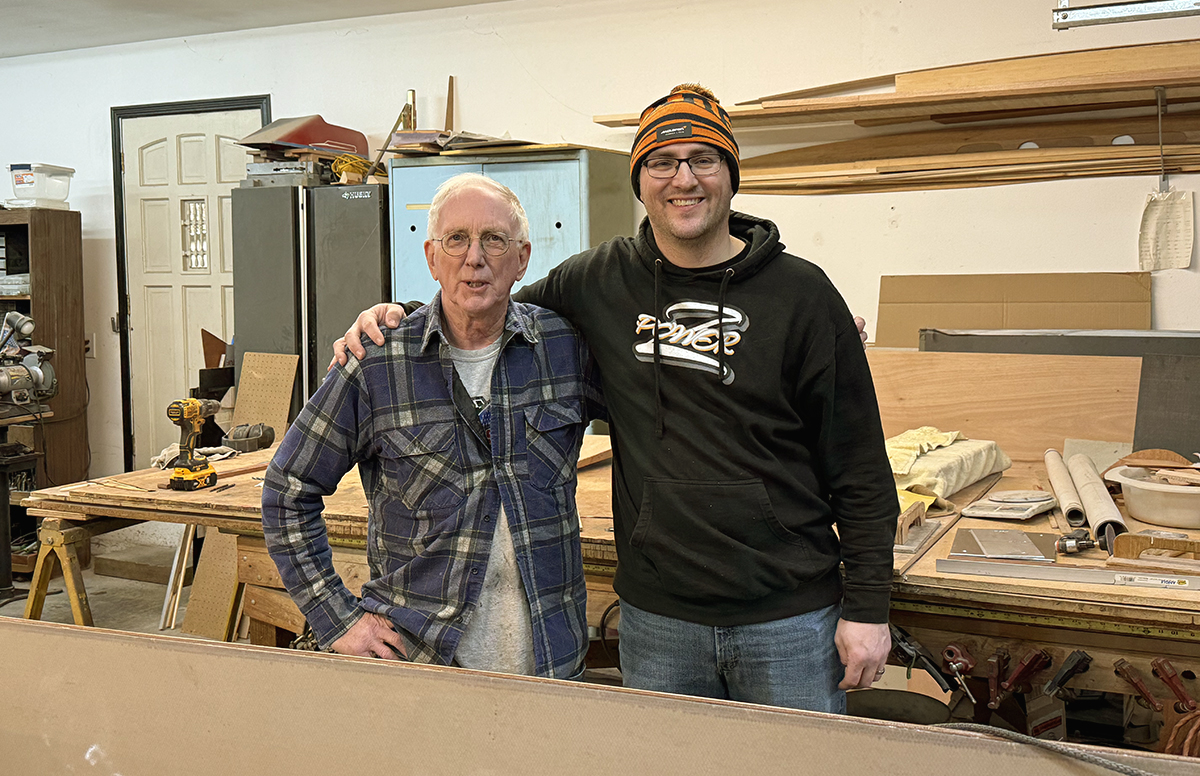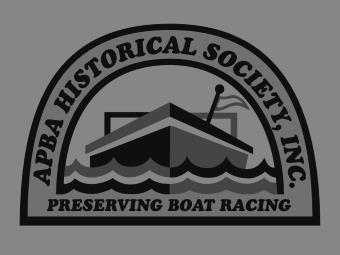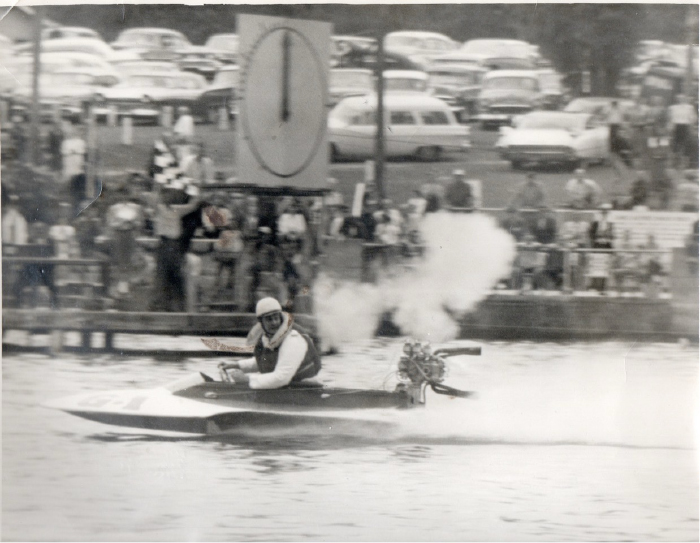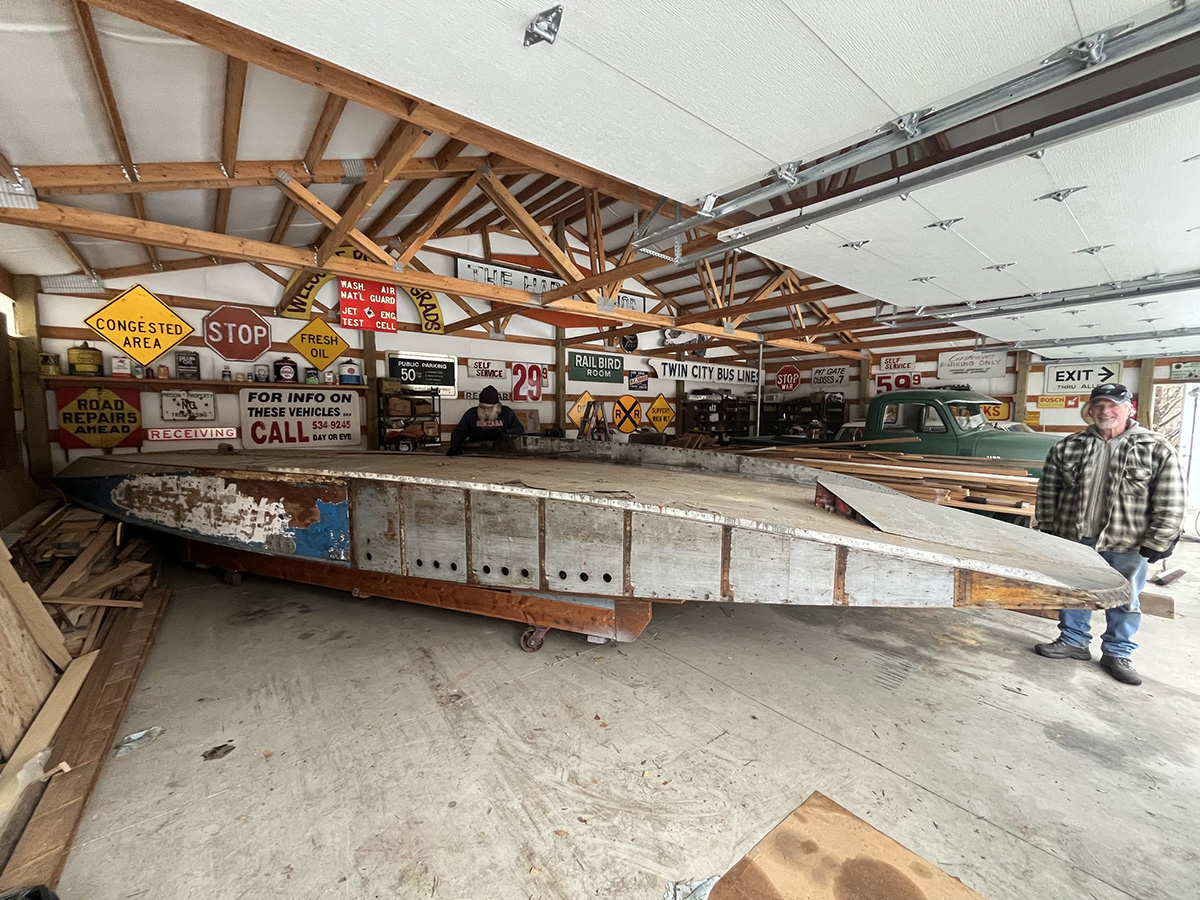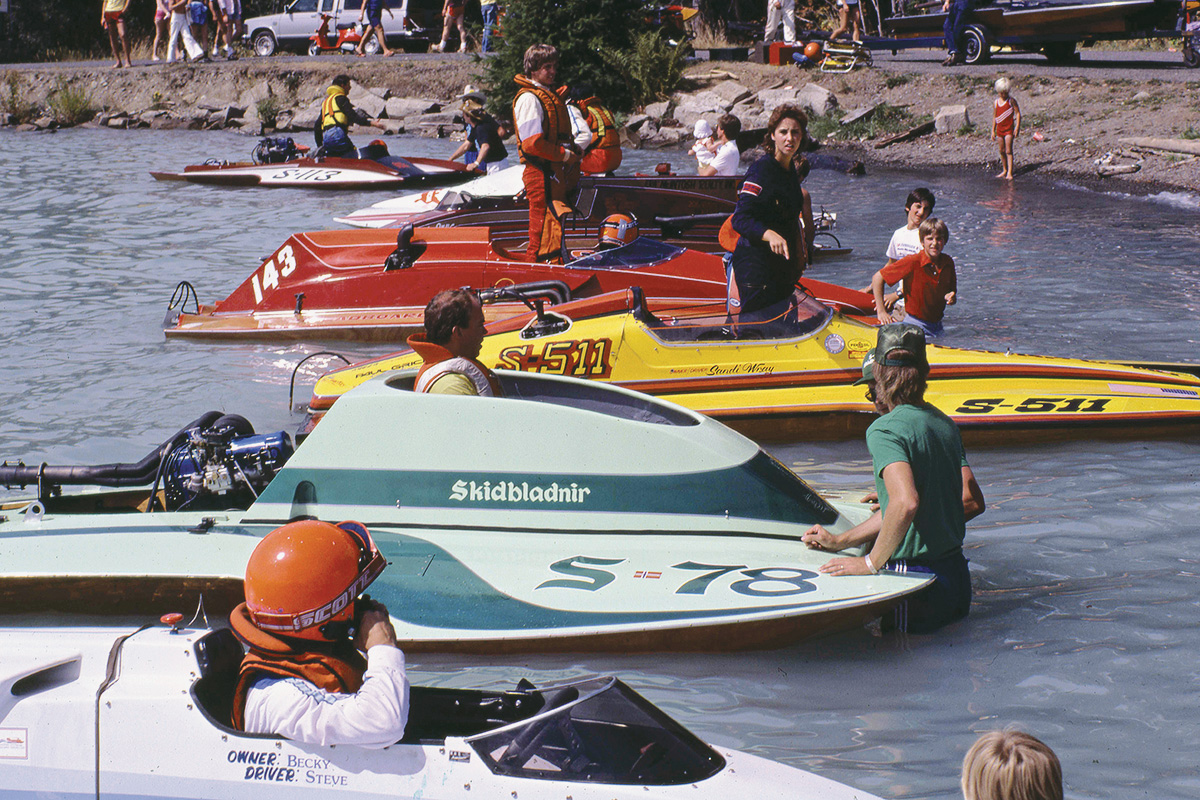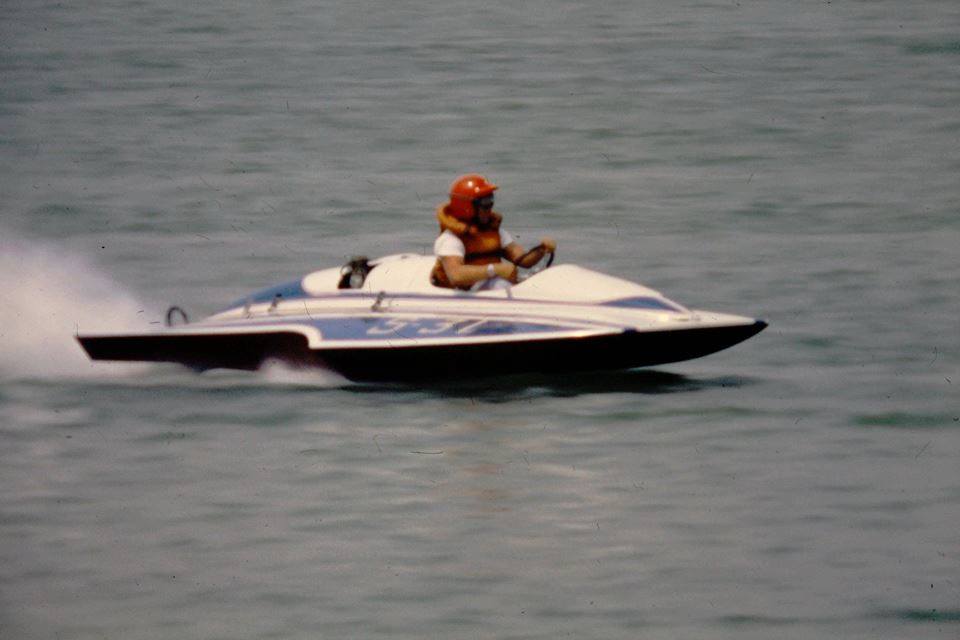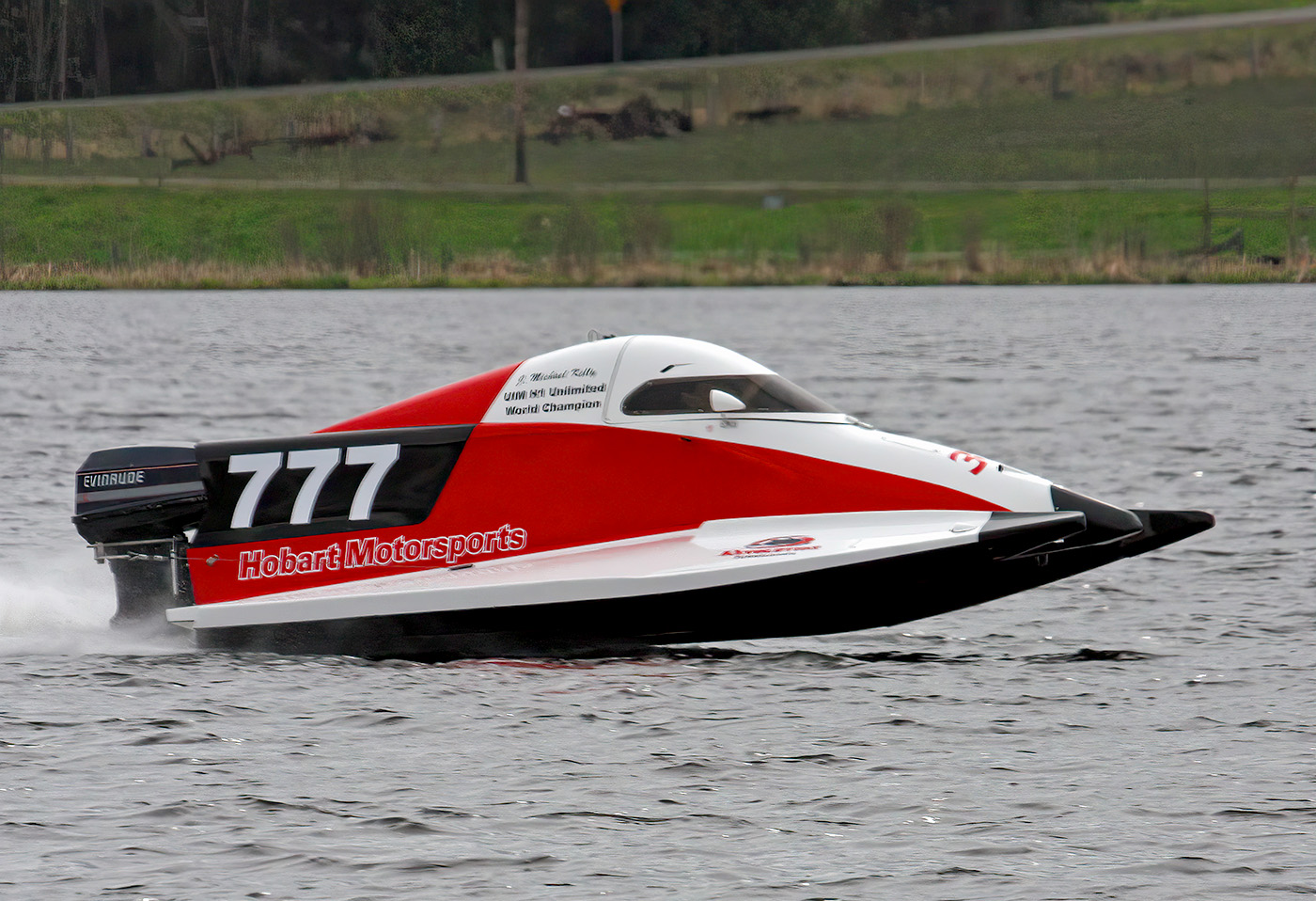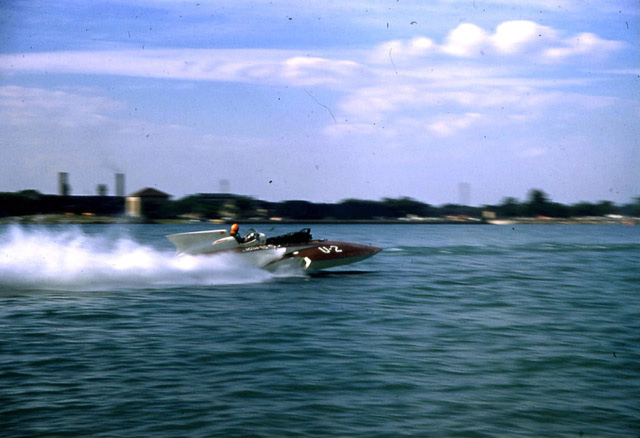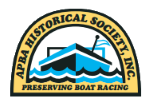An Interview with Howard Anderson, Jr.
December 23, 2022 - 10:05pm
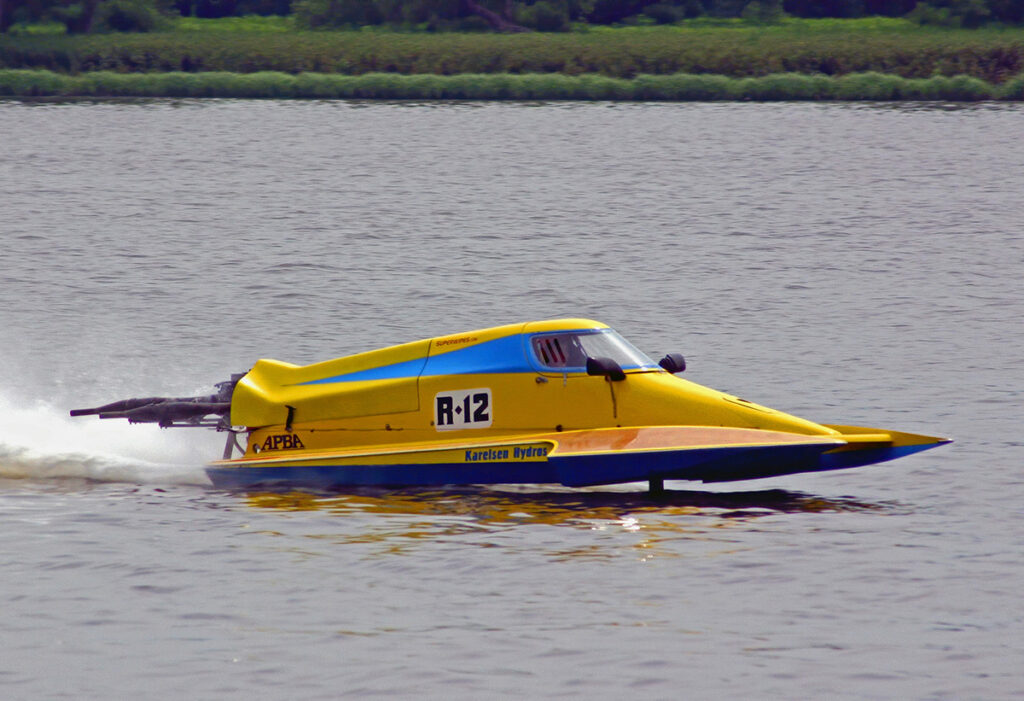
Howard Anderson in his 1100 Hydro with the enclosed cockpit. Gleason Racing Photography.
Howard “Andy” Anderson, Jr., was born in Seattle on October 27, 1927. He spent most of his adult life actively racing outboards. He served as Chairman of the Professional Racing Outboard category, was inducted into the APBA Honor Squadron, and set records. Andy was respected for his determination on the race course and for his ability to work with people to build consensus in his administrative capacity. Craig Fjarlie conducted the following interview at Anderson’s home in Edmonds, Washington, on September 4, 2010.
What can you tell us about your early life?
When I was about eight years old, we moved to Edmonds. We bought a so-called farm (it was five acres). We had pigs and chickens and cows and a horse. We did have a real farm later where we had five milk cows, and sold milk. I went to high school here in Edmonds. When I turned 18, I joined the Army. I was away a couple of years; and when I came back, I started Andy’s Boat House. By the way, my dad was a shipwright. He built ships and boats. None of it got on me, I’ll tell you. I wasn’t a boat builder. A friend of mine, also a young guy, was an electrician. He had a Hal Kelly design and got me interested, so we built a boat. He got tired of it, however, and didn’t show up much after we built it. Then I went to the Sammamish Slough race. I’d never been before. I was standing there around Bothell watching those guys come up the Slough, and it just really turned me on. I thought, “I could do that.”
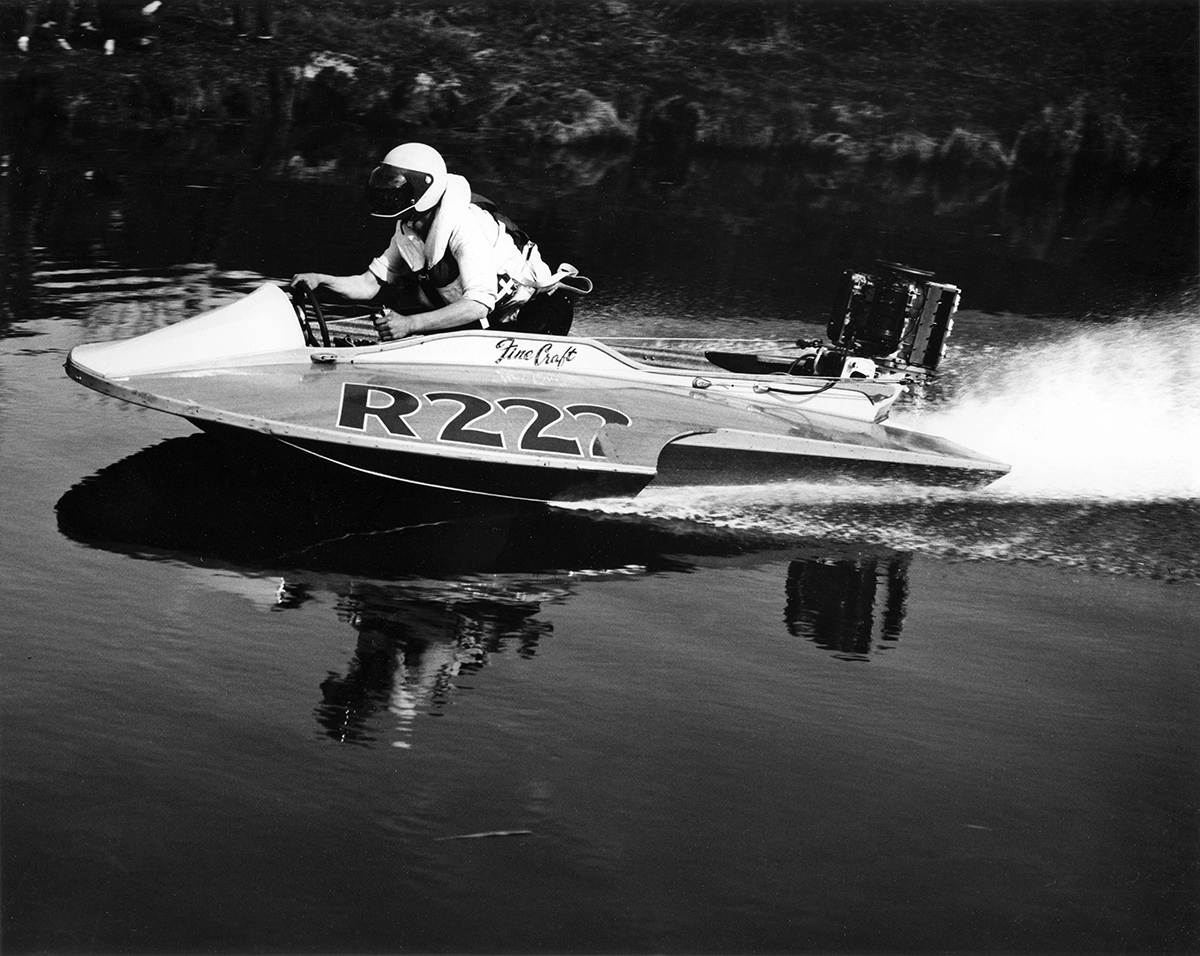
Howard Anderson, overall winner of the 1959 Sammamish Slough Race in Unlimited Class. Bob Carver photo, given to Jim Benson by Bill Carver.
So, you went to the Slough race for something to do?
Yeah, I went to see what all the excitement was about. I was proud that I’d helped build a boat, too. That got me all turned up, I thought I’d like to try racing. I wanted to buy a Midget (race car). Nobody had any money in those days. My folks said if I bought a racecar, I’d have to find another place to sleep. They just would not have it. When the boat came along, I kind of snuck it in. They couldn’t tell what the hell as going on. (Laughs.) Fortunately, I was a boat guy. I don’t know if it was all right or not, but they didn’t say much. Then I graduated through the ranks. I ran the Slough race the first two or three years, then branched out into circle racing. I was still a real novice.
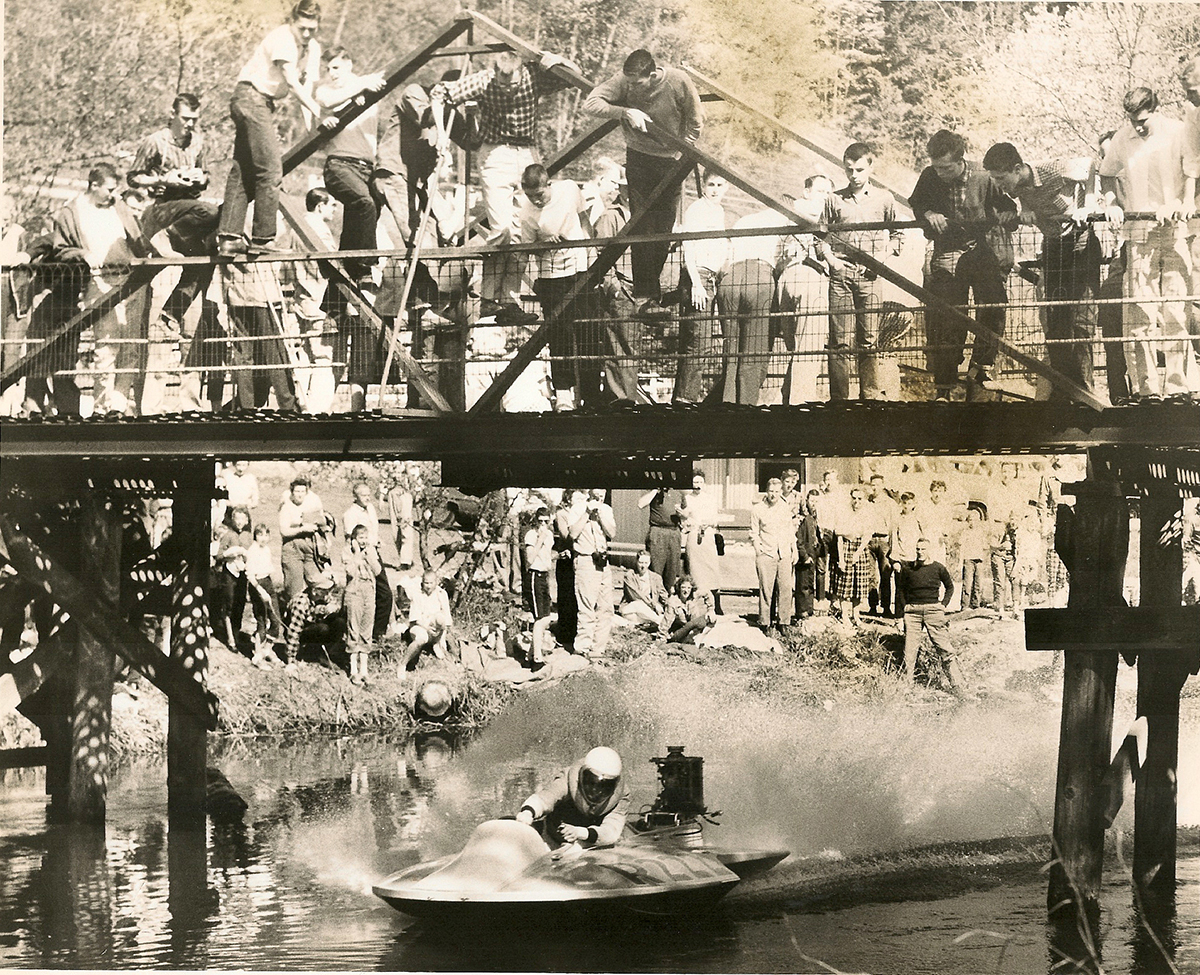
Howard Anderson, overall winner of the 1960 Sammamish Slough Race in Unlimited Class, taken by Bob Carver. Here he races under the Wayne Golf Course Nursery Bridge going downstream toward the Kenmore finish line. It’s the original unedited photo given to Jim Benson by Steve Greaves (on page 338 of Benson’s book Taming of the Slough).
About what year was the first time you ran the Slough race?
1959 was the year I won it, so earlier than that, for sure—early ‘50s.
What class was your first boat?
B Stock Runabout.
A lot of guys who had raced before the War, raced in the only outboard category they had. Then along came the Stock classes after the War. How were they at getting along? Did they welcome the Stocks as an addition, or was it an “us and them” situation?
We had very few of them, as I remember. I think a lot of them were at an age where they kind of gave up when the smaller cubic inch engines came out. There was no D Hydro then; it was A, B, and C, and F Hydro, and that was it. I was coming up through the ranks. I don’t know if I ever met them, but most of ‘em were not racing when I was coming through.
Do you remember meeting folks such as Lin Ivey or Jerry Bryant?
I met Jerry, but didn’t know him personally.
Al Benson? He was around for a long time.
Yeah, he was. He had a going outboard store and when we needed stuff, we’d go to him.
Bob Gilliam was around then, too.
Bob Gilliam was a good friend of mine. We grew up together.
Jimmy Harland was around then.
Never met Jimmy Harland, but he and Bill Rankin were very close friends.
You must have known Billy Schumacher back in those days.
Oh, sure.
Did he show signs of being a top driver back then, when he was getting started?
Yeah. He had fast stuff and he drove well. He was tough—very good.
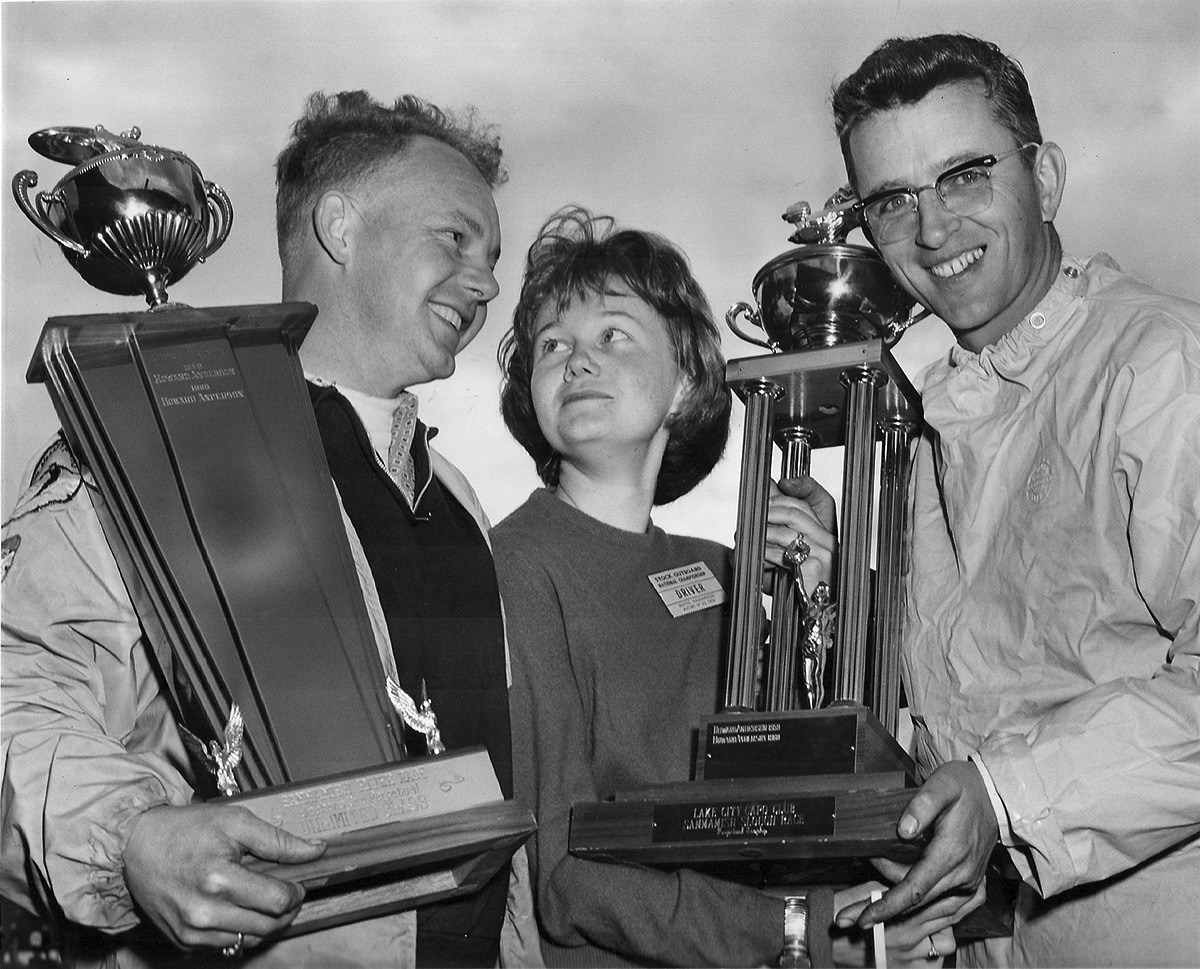
L-R: The 1961 overall Sammamish Slough Race winner was Wendell Ewing (Howard Anderson’s crew chief for 1959-1960) with new wife Penny and the prior two years’ winner Howard Anderson holding winner trophy on right. Photo taken by a Seattle Times staff photographer, given to Jim Benson by Steve Greaves and is unedited. (It appears on page 334 of Taming of the Slough).
After you had the first boat that you built, you saw faster stuff. What did you move up to next?
I stayed with B Stock. I didn’t build another boat. When I started at the races, I just had a B Runabout. Another guy had an old used hydro. Sitting on the beach watching him race, I said, “Well, it’d be more fun to have two. Might as well get another boat.” So, I gave him a hundred bucks for his boat. It took me about six months to pay him the damn hundred bucks, but I got the boat paid for. It was a Welland, built in Renton (Washington). Welland was a pretty good boat builder, for his day. He had lots of good ideas. The next boat I got was also a Welland, and I even went so far as to get a D Stock Welland. By then I had bought a D engine. With that Welland hydro, I won a lot of races. I got into a real racing engine and met Doc Jones. Jay Jones, his brother, was living in Edmonds. We got to be pretty good friends and we tested in salt water at night. It was real calm, with no boating going on in the summertime. We called Jay up and had him come down. I said, “Is that motor revving like it should?” We had no clue what anything should be like. So, we’d get a guy like Jones to come down and listen to it idling, out there in the chop.
I blew that Welland over in ‘57. I was racing at Green Lake and running a Bluey box in kind of a half-hearted F, a four-cylinder D motor. I blew it over and broke my back.
You mentioned a Bluey box. Can you explain what that is?
It’s just a frame around the left side of the engine. You know that plate? Pull that plate off and put on that Bluey box…it followed that thing right around. You had to make sure you had the water hole lined up so the water would circulate. Pistons went up and down and exhaust came out the side of the engine.
Where did you buy racing engines?
An old guy had a marina on 85th and Aurora (in Seattle), Sno-King. He got hooked up with Mercury engines. A guy named Jack worked there who had raced with Seattle Outboard. He went on to be the skipper on John Wayne’s yacht. Jack and I got to be good friends. He was a good friend of Bill Rankin, too. I didn’t know Rankin then. Anyway, that’s where I bought an engine. Knew nothing about it.
You got into the PRO category eventually.
Yeah, I joined PRO the minute I took the Bluey box off my D Stock engine. I’d take it off and put it on. They kind of insisted I run fuel and open stacks. They didn’t really want me in there at all. I just bulled my way in. We’d pull the carburetors and side plate and put the other Bluey box on it, with different carburetors, and away we’d go, burning fuel.
Were you buying fuel from Hal Tolford?
Uh-huh.
He got into a little trouble selling it when he wasn’t supposed to.
Well, he lived in the city, in a private home, and he had nitro and everything in his garage. He could have blown up half the town (laughs). Never used that stuff, but I got all my fuel from him.
Some new engines in the PRO category came along in the ‘60s, the Crescent and Anzani.
Ron Anderson and a few of the guys got hot on the Anzanis, and Ron really worked them and raced them himself. They must’ve burned a thousand pistons. They were nitro guys; they were burning nitro and they burned pistons, but they fought the battle and got ‘em to run finally. They were fast. The Crescents didn’t go over; no one got excited about them.
That’s before the Konigs came in.
Well, O.F. Christner, in the late ‘50s, was rebuilding Quincy engines. For a few hundred bucks you could get a pretty damn fast engine—a lot stronger than a D Stock. It would come out of a corner about as fast as a D Stock would go into a corner—really, quite a bit of difference. So, that was a big deal. For everybody who was interested in PRO racing, he put stacks on it. The first four or five weren’t too good, but all the guys that wanted to go fast bought them. Soon as I knew about them, I sent my D Stock off to him and here it comes back, a race engine. Then in the late ‘50s, Harry Bartolomei from California got in tight with Konig and they had a two-cylinder engine. But in those days, the rules said no foreign engines. I remember they had a PRO Commission meeting at a Holiday Inn in DePue. Must’ve been in the early ‘60s. Bartolomei was telling everybody, “We got this German engine; it’s the best we got going.” He beat on the drum loud enough that they finally changed the rules. About two years later that was the end of the Crescent—it couldn’t keep up. The Konigs got in there and started getting better and better. In a few years the Konig was the only way to go.
Well, it changed the PRO classes completely. They went from being a few miles an hour faster than Stocks to 30 miles an hour faster.
Yeah, way faster.
Gilbert Peterman was away for awhile. When he came back to run the same class, it was twice as fast as what he’d driven before.
Yeah, he wouldn’t let anyone inspect it, though. Never got inspected. Set a record and oh, that’s it!
You did run a Quincy for a while.
Quincy came out to counteract the Konig. They came out with a different engine, a loop-charged engine. It was faster than the Mercury. In fact, it was pretty damn fast. It was a really good engine.
What class was that used in?
I know B, C, D, and F.
And you ran in those classes with it?
The front end of the engine—pistons and the crank—were Mercury. The thing he changed was the powerhead. All the other stuff was Christner’s. It was a lot faster than the deflector! I ran those for a couple, three years. They were fast, but the Konigs kept getting better and better and there were more of ‘em out there. Finally, the distributor said, “You gotta get a Konig.” At DePue in those days – I always went to DePue – I could stay with the guys down the chutes. I’d go in the corners just flat out and they’d go by. They had power in the corner and they’d accelerate faster. Finally, I had to get Konigs. Kind of a hard lesson to learn.
Were you doing some of your own mechanical work on them?
I was trying to, but I didn’t know diddly about them. Eventually I got Bill Rankin, one of the old timers, to help. He could take one of those flatheads and put it together better than anyone in the country. They were always fast.
How did you get hooked up with him?
Oh, I was a Mercury dealer and he worked for Mercury, or he worked for Marine Supply in the parts department, and we just got to be friends. I asked him, “Can you machine this, or can you do that for me?” and finally I just ended up taking the whole thing down and he built my engines.
Took it to his house in Richmond Beach?
Go down every weeknight, all summer long. I’d get there about 7:00 and he’d come downstairs. We worked ‘til usually about 11:00. Built a flathead, or fixed an old one, or something, lower units. The guy was so good with tech stuff. He got the bug one time. We were still doing all these engines, but he wanted a player piano. He got one that wasn’t working. He took that thing apart and made all the little wooden bellows, put the fabric on ‘em, all the tubing. Took it all apart, put it all back together, and when he cranked it up it would hold vacuums longer than a new, professional one would. Best damn piano in town. He built two of ‘em—he liked ‘em. But when he died they were still sitting there. I didn’t buy one; could have gotten it for nothing. But Bill Rankin was something else. He knew more about C Service and Racing C than, I swear, any man in the country. He just knew it all. Before I met him, when he was a bit younger, he lived in Richmond Beach. Before that he lived down by Woodland Park (near Green Lake – Ed.). He had a separate garage where he worked on engines. He had a water barrel he could test them in. He used to build four or five C Service engines, used all kinds of tricks on ‘em, trying new stuff. If it didn’t work, he’d throw it away. Parts were available and he worked on those Service and those Racing Cs. He really knew what made them work. He was fast. He was racing himself in those days. I never saw him get beat. It was the same in C Service—he was the best.
What are your memories of Hugh Entrop?
I knew him pretty darn well. He was just a regular old shoe, an old boat racer. When he started out, of course, he didn’t have any records or anything. You know, just one of the boys racing. His first engine was a Bluey box engine. He kept building his own boats. He didn’t build boats for anybody else. I didn’t know him too well until after he set the first record. He went 100-something.
Yeah, 107.
Then he started coming to me, talking in the pits, and we got to be pretty friendly. He was one of those guys who, if he started something, he would just dive into it, like photography. When he quit racing, he got into photography. He was taking pictures of stars, scientific stuff, but that’s the kind of guy he was. And he had tricks for building a hydro that nobody had. He figured his engine was always around 90 horsepower. He didn’t have a souped-up Quincy engine to set records with; it was a stock Mercury. They had put pipes on one, but didn’t do anything to it.
How about Burt Ross—how do you remember him?
We were good friends; went skiing in the mountains two or three times. He was pretty happy skiing and so was I. We had a cabin up there and he’d come up and spend the weekend and go skiing. Racing, he was one of those guys that, if he was running D Stock, in the later years he was running a 44. Seemed to be running a D and winning all the races in California. He was a nice guy and a pretty good boat racer. When I got my first D Stock, I made up my mind, “Someday I’m gonna beat Burt Ross.” He was the guy—it was just impossible to catch him. By God, I finally got a good engine and a good set-up. I went to Green Lake and I beat his ass all two heats. (Laughs.) I rubbed it in. I stormed down there on the start and backed off. I was just a shade early and I slowed down a little bit. He went up and we got on it pretty good and I started going by him… They were all good guys, like the guys I know today. They were always fooling around with their engines, but they weren’t Bill Rankin. They’d try this and that. But, even then with my D Stock with the Bluey box and fuel, I won my share of the races.
In those days, you ran things such as the Slough race, a long-distance marathon, and circle races. How was your set-up different for those two styles of races?
It was more engine work, I guess, than boat work. You used the boat you had. A lot of the guys did fiddle with the fins quite a bit, so they could turn both ways easier. Guys were putting the fins on the other side, the bottom of the boat, screwing around with ‘em to make right turns. I never did. The two years I won it I ran a Quincy flathead. I burned fuel, no nitro. Burned alcohol. Most of them would add little tanks to make ‘em go that far, and all that, but there was no big change to anything that I saw.
One of the things you did later was become involved with APBA politics. Were you ever Commodore of Seattle Outboard Association?
No, I never was anything in the club. I don’t know why I didn’t choose it. I didn’t ignore it; I was into it pretty deep, but I just stayed away from it. I didn’t like the local, but then I ended up going into the national politics and I really liked that.
What was your first step into that?
I was appointed a Commissioner by Mel Kirts when he was the PRO Vice-President, back in the ‘70s.
How long were you on the Commission in that position before you became PRO VP?
(Long pause. Finally, he asked his wife, Penny. She replied, “Eight years.”)
When you ran for PRO VP, were you unopposed?
No, I had Kay Harrison running. He was a big guy with the Title Series back east. I just knew I didn’t have a chance. They were really working at it. They had big signs at the Nationals, “Vote for Kay Harrison.” By God, when it finally ended up, I got the votes. I was amazed, and I was VP for 10 years. It finally just kind of wore me down. I wasn’t getting any new thoughts and I was ready to quit. So, then they elected Steve Greaves. He’s been Chairman probably 12 years now.
During the time you were PRO VP, what do you think were some of the major accomplishments by the PRO Commission? The Title Series was in existence at that time.
Oh, yeah, they were big time at that point. C Service was one of my biggest ones. It was gone. Two guys that they added kind of had it sewn up as far as racing and rules. They allowed Mercury into C Service and that just pissed a ton of people off and they quit racing. I worked with Greaves and the local guys, John Laird and all those, guys from the Midwest. They were fighting the battle, too, trying to get their rules approved. It was all screwed up. When I was elected, I said, “I gotta do something about that. I don’t want to lose them.” By that time the Mercurys were gone, but the class was down in the dumps. To make a long story short, I started talking to these two guys from the Midwest. They came when the meeting was in Seattle. I went out in the hall during the meeting. I shut it down and went down the hall and met with these two guys and we went at it. I said, “We’ll do this and this and this and go by what you say in the rule book pretty much, and we want it back in APBA. You guys think about that, come back in the meeting and let us know what you want to do.” I went back into the meeting. I told the commissioners, “When they make a motion, don’t anybody ask a question. Nobody votes ‘No.’” I really got on their ass. I didn’t want them to say a word except, “Yes, we want you.” And that’s how it happened. They did vote for their case. The guys came in and said we want to approve what you want to do. So, they came back into the fold as the Antiques. But, too many guys didn’t like the Mercury being run with the Antique engines.
You drove a capsule boat. How did it feel? What was the difference sitting down with a cover over your head?
I was pretty comfortable in there. Two hands on the steering wheel made a helluva difference to me. Really, I have to relate it to driving a car. Get in there and sit down, it’s natural, you know? Drive a car that way. Had a foot throttle and pipes and all that stuff. I remember going through a real hard first turn at DePue. I was in second, I suppose. There was a hot dog outside of me in a laydown. In the turn he goes around me. He was bouncing and twisting. I thought, my God, am I glad I’m in here, not in that. They could drive it harder. They weren’t any faster at that time, but they could drive it in the corner and go through the corner harder.
You were strapped in?
Oh, yeah, strapped in right from the start. No air supply. I did get it upside down. I got a bad start and was probably in third. I just tore into the corner, the first turn, and I hit a roller or something. Right sponson dug in and she spun me. Doing probably 100 miles an hour when I hit that thing and I turned around. I was looking out the side window. I thought, ah, there’s the sunshine still. I can see something. It was still up above water, you know, it was really weird. I thought, at least I didn’t go upside down. I took a big breath and it was nothing but water. I was upside down. Then it was dark and black. What in the hell is going on? I knew I had to be inverted. I was reaching down. No, I was upside down. The bottom was just floating level. I said, “Oh, it’s gone.” Then I got the steering wheel loose. Do I want a trophy? I’ll never see it again. So, I dropped the steering wheel. From then on, this is like probably 30 seconds had gone by, pretty bad off in there and I wasn’t moving. I just couldn’t seem to move. I couldn’t even tell you what was going on. I finally found out I had swept off the end of the head part of the canopy and my ass was stuck in there. Came up the taper and just jammed in there. Finally, something came by my foot, something solid, one of the comings or something, and I pushed on it. If that hadn’t happened, I wouldn’t be here. Got me right loose and away I went.
Near the end of your racing, you drove 1100 Hydro and 1100 Runabout. Did you have a preference, or did you like them both?
Yeah, I did. At the Nationals, back in ‘99, or ’01, or somewhere in there, I had always raced with my son-in-law. He’s in California. He ran a Racing D Hydro. He was pretty serious about that, too, and he spent a lot of money on props and sending his engines to guys. It got to the point where running the runabout and the hydro was just wearing me out. I said, “Do you want to drive the hydro?” He said, “Sure.” I think he won five or six national championships with the hydro when he started driving it. So, then I just had the runabout to worry about, and that was enough. And I can say I had luck going with the runabout. I set a world record one time and never even knew it. It was just a regular race to me. (Laughs.) That’s the way to set a record. It was fun. The hydro cockpit was actually more attention and more worry. You couldn’t see anything, like the start clock. Go past the clock on the back chute. Finally locate it, you know. See what was going on with the line. Go to the upper turn and all the way around the corner before you knew what the hell was going on. You had no clue. You always had to be up in there—then you were fine. It’s hard seeing around boats and spray, that was the problem. Where’s the starting line from me? Most of the guys had radios. I didn’t have one. I couldn’t afford a radio, and I didn’t want one, but it was the same for everybody.
You were involved with a UIM World Championship event. There were some problems.
First one they had in America, I guess. We had a World Championship in Pleasanton, California. Harry Bartolomei was Italian and he went to Italy a lot. I can’t remember much about it. Harry told us he’d filled out all the papers, but he didn’t. You have to get approval. They had 350 and 700 classes, and they had a lot of foreign drivers. We sent in all the paperwork, and the guy that won was an American. I can’t remember all the ins and outs, but we gave away all the badges and stuff and went about our business. Pretty soon all hell broke loose. They found out the Mexican guy didn’t know anything about this. Oh, was there a Mexican that won it? They ran the Mexican flag and they weren’t approved but Harry Bartolomei didn’t do anything about it—he just let it go. So, it all went through and then the Mexicans found out this guy, here he is, he won it, and we don’t know who he is. That year was, I think, the first year UIM came to America to have their meetings. I had to go explain the problem. It was quite exciting. I really enjoyed it. Great big table and they’re all talking funny languages, and there’s a woman talking all the time translating in English.
Everybody’s got a mic. All foreigners, all different languages all the way around that table. Old guys that didn’t know a boat race from nothin’. That’s what bothered me about UIM. It’s run by a bunch of guys that don’t know what the hell they’re doing. I gave ‘em a sad story about how it happened. I didn’t tell them what all happened, it just got mixed up or something. Gave them a bunch of BS and they bought it. That was sure interesting. I was amazed, how could you have a meeting with all those people and get anything done? They can’t. They all got a vote.
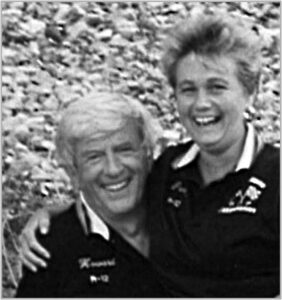
Howard and Penny Anderson, both APBA Honor Squadron inductees, courtesy of Penny Anderson (photographer and year unknown). This photo appears on page 523 of Taming of the Slough.
You were elected to the APBA Honor Squadron in 1995. Not many people earn that distinction.
I guess it was for doing the hard work with the PRO Commission for 10 years, and I was elected the category Chairman of the Board, so I got to serve on the Board quite a bit, on and off for years. I was the most shocked guy in the world when I got the call from APBA Executive Administrator Gloria Urbin that I was a member now of the Honor Squadron. I couldn’t believe it. I didn’t do anything special. Did a lot of Commission work, and a lot of people thought I did very well. That was most of the reason, my work with the Commission. Quite an honor.
Did you ever have any desire to be APBA President or anything like that?
One year, the last, I ran for Vice-President. (He lost to Don Allen – Ed.) I finished. I don’t want to do that any more.
How has outboard racing changed, from your first race to the present?
I would say maybe rules, would be one thing. There are some that are gone and more added and sometimes I think we’ve got too many rules. That’s kind of changed throughout the years, but not too much. Speed is something that gets you. One year you’re doing 75 and the next year you’re going 85 and the year after that you’re going 95. It wasn’t quite that fast, but the speeds sure changed drastically over the years. I don’t know when it was, early ‘70s, late ‘60s, we ran out of boat. The motor was way faster than any boat we had. We were breaking guys up; they were going to the hospital. The boats were just too fast for the design. Then the design changed and that got to be no problem at all. Then we took the weight off and everyone said, “That’s the end of it, they’ll be killing these guys now.” Didn’t matter when we took the weight off. I’m still against it. Don’t mention weights to the PRO Commission—they’ll come after you. That’s the big thing, the weights. Motors changed and the boats didn’t keep up. The boats had to change. Once the boats got in control it was safer. I had a Marchetti— you could drive it as hard as you could drive it with a flathead on it. With a Konig it wouldn’t do anything. Just drive it, you know, around the corner you go. Beautiful boat. It was even a conventional, with a solid bow on it. I had four or five of those. Finally, they went to a kind of a semi-pickle, but they were great boats, and safe.
Round bow.
Round bow before the pickleforks, yeah. When the pickleforks were coming in, I was still running the round bows and beating them.
Did you do any of your own mechanical work?
I learned to work on an engine pretty much. I can do a lot of it. I can take a Konig apart and put it together and get it ready. I learned a lot, but I don’t profess to be a mechanic. I wanted to drive but I wanted some other guy to work on the engine. Finally got there. Got another guy to work on the engine. You go down there and the unit was busted. He’d get on it and it was ready to go. Wonderful feeling. And we showed ‘em—we raced well.
How many years did you actively race? Was it more than 50?
- Maybe a little more than that, but I can say for sure 55, continuously. I just never really got excited about records. But I enjoyed the political part, too.
Well, thank you for your time.
Editor’s note: Howard Anderson passed away on September 19, 2013.
Featured Articles
